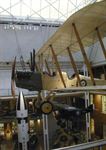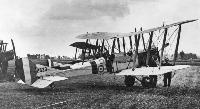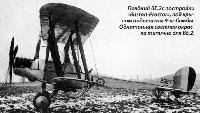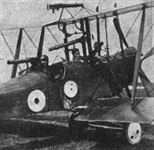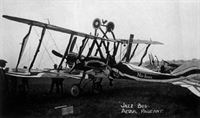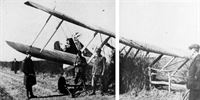
Варианты
- RAF - B.E.2 - 1912 - Великобритания
- RAF - B.E.8 - 1913 - Великобритания
- RAF - B.E.2c/B.E.2d - 1914 - Великобритания
- RAF - B.E.9 - 1915 - Великобритания
- RAF - B.E.12 - 1916 - Великобритания
- RAF - B.E.2e - 1916 - Великобритания
Royal Aircraft Factory B.E.2
<...>
Более массово выпускался вариант B.E.2c с двигателем RAF 1 а мощностью 90 л. с., ставший первым самолетом, оснащенным пулеметом. Другое вооружение было установлено на самолете B.E.2d, тогда как на варианте B.E.2e установили новые крылья и хвостовое оперение.
На Западном фронте воевали самолеты B.E.2d/e, а более ранние модификации использовались в Великобритании и на других ТВД как учебные. Недостаток маневренности сделал его легкой мишенью в периоды воздушной войны, когда у противника появился "Бич "Фоккера" (1915-1916 годы) и в "Кровавый апрель" (1917 год).
Общий выпуск самолетов семейства B.E.2 превысил 3500 машин. Самолеты в основном стали сниматься с фронта в 1917 году, а после Первой мировой войны активно использовались в качестве учебно-тренировочных, связных и противолодочных патрульных в прибрежных районах.
- Описание
Фотографии
-
История Авиации 2002-01 / А.Сергиенко - Первые асы Британской Империи /Пионеры/ (1)
Регистрационный номер: 1748 [2] B.E.2c 1748 из 6-й эскадрильи, июнь-июль 1915г. Среди прочих пилотов, на нем, возможно, летал и капитан Хокер. Опознавательные знаки только на хвостовом оперении.
-
Мировая Авиация 225
Регистрационный номер: 2633 [2] После вывода с Западного фронта многие B.E.2c продолжили нести службу в Королевском летном корпусе в качестве ночных истребителей и обороняли Великобританию
-
История Авиации 2002-03 / А.Сергиенко - Первые асы Британской Империи /Пионеры/ (3)
Регистрационный номер: 2673 B.E.2c 2673 на котором в сентябре-ноябре 1915г. летал 2-й лейтенант Гарольд Медликотт, 2-я эскадрилья, аэродром Эдиньель. Окраска относится к августу-сентябрю 1915г., когда машина только попала на фронт.
-
Мировая Авиация 225
После Первой мировой войны B.E.2 эксплуатировались в авиакорпусе Армии Норвегии (на рисунке). Другими эксплуатантами были Австралия, Бельгия, Греция и Американский экспедиционный корпус.
-
Air Enthusiast 1972-02 / L.Coombs - Front-office evolution (1)
"...the early style of cockpit soon gave place to the shoulder-high type, and small windscreens had to be fitted". The S.E.5A provides a good illustration of this evolution, when compared with the B.E.2C, a replica of which is shown below.
-
Авиация и Космонавтика 2014-09 / М.Никольский - Фарнборо-2014 /Выставки, смотры/
Историческая демонстрация воздушного боя
-
Авиация и Космонавтика 2018-10 / Е.Казеннов - Авиашоу "RIAT-2018"
Другие самолёты на фотографии: Fokker Dr.I - Германия - 1917
-
Aeroplane Monthly 1999-05 / 1999 UK Airshows & Museums Guide
Регистрационный номер: 2699 [4] Royal Aircraft Factory B.E.2c 2699 is suspended in the atrium of the Imperial War Museum.
-
Aeroplane Monthly 2000-04 / 2000 Airshows & Museums Guide
Регистрационный номер: 2699 [4] The IWM’s B.E.2c 2699, with Camel keeping formation beneath.
Другие самолёты на фотографии: Sopwith Camel / F.1 - Великобритания - 1916
-
История Авиации 2002-01 / А.Сергиенко - Первые асы Британской Империи /Пионеры/ (1)
Регистрационный номер: 1748 [2] "Ливерпуль" (B.E.2c 1748) вскоре после постройки.
-
Aeroplane Monthly 1988-09 / L.Balfour - A portrait of Dowding
Регистрационный номер: 1749 A camouflaged B.E.2c with an RAF Ia engine and vee undercarriage. It is said that probably no other aeroplane of World War One, Allied or enemy, was so vilified as the hapless B.E.2.
-
Air Enthusiast 1999-03 / B.van der Klaauw - Unexpected Windfalls
Регистрационный номер: 1754 BE.2c 1754, landed on Dutch soil on March 10,1915, and subsequently went to the LVA as LA-24.
-
Aeroplane Monthly 1982-12 / W.Fry - Scout pilot
Регистрационный номер: 2502 Two views of B.E.2c 2502 of “C” Flight 1916. As a 2nd Lt the author flew this aircraft on several occasions.
-
Aviation Historian 9 / A.Roberts - Death of a Visionary: Edward T. Busk and "Stability Jane"
Регистрационный номер: 2633 [2], 4172 By the spring of 1915 B.E.2cs had become standard equipment for first-line Royal Flying Corps squadrons on the Western Front. These Daimler-built 90 h.p. Royal Aircraft Factory 1a-engined B.E.2cs were photographed in France in 1915 while serving with No 16 Sqn, which had received its first examples in February of that year.
-
Мировая Авиация 212
Регистрационный номер: 2687 Поздний BE.2c постройки "Ruston-Proctor", под крылом подвешены 9-кг бомбы. Однотонная светлая окраска типична для BE.2.
-
Мировая Авиация 212
Регистрационный номер: 4143 Снимок этого BE.2c сделан в марте 1917 года. На фотографии заметны изменения, внесенные на протяжении войны в конструкцию самолета, - вертикальное оперение треугольной формы и элероны.
-
Flight 1935-05 / Flight
This machine was designed by the Royal Aircraft Establishment. The B.E.2C was an automatically stable tractor biplane with 90 h.p. R.A.F. engine.
-
Air International 1996-06 / R.Whitford - Fundamentals of Fighter Design (1)
Регистрационный номер: 8719 Aircraft design is, almost without exception, a compromise. By changing the CG position and making slight modifications to the tail surfaces, the unstable BE2A was transformed into the stable BE2C (seen here). However, improvements in its flying characteristics reduced its manoeuvrability, rendering it unsuitable as a fighting machine.
-
Air Enthusiast 1996-11 / R.Normann - Mespot Squadron
Lts Page and Rattray beside their BE.2c after the collision with a German machine on April 3, 1917. Note the wingtip is missing.
-
Aviation Historian 6 / G.Ellis - Hunting the Lion of Afrika
One of a number of photographs taken by Capt Henry C. Brocklehurst of No 26 Sqn while in East Africa. Although it was rapidly becoming obsolete by 1916, the B.E.2c proved to be a reliable workhorse for 26 Sqn, its inherent stability making it a steady platform for its photographic reconnaissance role.
-
Aviation Historian 6 / G.Ellis - Hunting the Lion of Afrika
A pair of B.E.2cs of 26 Sqn at Njombe, now part of Tanzania. One of the unit’s observers was Leo Walmsley, who went on to become a well-known writer, and who wrote of his experiences of First World War East Africa in his 1944 memoir So Many Loves (Collins).
-
Aviation Historian 6 / G.Ellis - Hunting the Lion of Afrika
Регистрационный номер: 4548 -
Aeroplane Monthly 1981-11 / News Spotlight
The Imperial War Museum's BE2C was moved from London to Duxford for complete restoration in 1980. It has recently emerged from Duxford looking immaculate. The aircraft is Duxford's oldest aeroplane, being built by Ruston, Proctor and Company of Lincoln in 1916.
-
Мировая Авиация 225
Самым известным вариантом B.E.2, прослужившим дольше всех, оказался B.E.2c. Вначале он использовался как бомбардировщик, хотя быстро стал уязвимым от атак современных немецких истребителей. Данная машина вооружена двумя пулеметами Lewis.
-
Aeroplane Monthly 1986-01 / 1986 UK Aircraft Collections and Museums Guide
Регистрационный номер: 2699 [4] B.E.2c 2699 and R.E.8 F3556 are Duxford’s oldest aircraft exhibits.
Другие самолёты на фотографии: RAF R.E.8 - Великобритания - 1916
-
Air Enthusiast 1997-03 / A.Thomas - More from Mesopotamia
BE.2cs at Shaikh Saad being readied for the last Kut food drop, April 29, 1916.
-
Air International 1979-02 / J.Bruce - The First British Armoured Brigade (1)
This "home-made" armoured single-seat B.E.2c was a local modification made in the Middle East, possibly by No 14 Squadron. Protection appeared to be confined to the cockpit area.
-
Aviation Historian 16 / W.Robinson - The Reluctant Overnight Hero
Регистрационный номер: 2693 [2] Lieutenant Leefe Robinson poses in the cockpit of B.E.2c 2693, in which he shot down SL 11; the airmen beside the starboard wing are holding the upper wing’s original centre-section, which was probably damaged when Leefe Robinson shot away the wire guard that prevented the Lewis gunfire from hitting the aircraft’s structure.
-
Aeroplane Monthly 1988-01 / G.Parry - Images of War (3)
A B.E.2c of No 2 Squadron at Hesdigneul in 1916. The observer holds an aerial camera, and a ground-type Lewis gun can be seen on the centre-section strut. In the event of interference from the enemy the observer/photographer had to stand up to fire the Lewis.
-
Aeroplane Monthly 1985-06 / P.Lamboit - Eyes in the sky (1)
A B.E.2c, named Tasman, photographed in 1915.
-
Aeroplane Monthly 1990-05 / Jumbo /Press Call/
Location and date of this World War One photograph is not known. In the background is a B.E.2c.
-
Aviation Historian 17 / M.Parry - Major Horace Buss
A pair of Royal Aircraft Factory B.E.2cs flank a Deperdussin Monoplane, both types flown by Buss during his wartime flying career, at Felixstowe in 1915. The 100 h.p. Gnome-engined Deperdussin saw RNAS service in small numbers.
Другие самолёты на фотографии: Deperdussin B/C/D/TT - Франция - 1911
-
Air Enthusiast 2006-05 / M.Rogers - Between a Rock and a Hard Place /World war one/
DH.9 of 144 Squadron with a Bristol F.2b and BE.2 at Azrak landing ground.
Другие самолёты на фотографии: Bristol F.2A/F.2B Fighter - Великобритания - 1916De Havilland D.H.9 - Великобритания - 1917
-
Air Enthusiast 2006-05 / M.Rogers - Between a Rock and a Hard Place /World war one/
No. 144 Squadron DH.9 at Azrak with a pair of F.2bs from 1 Squadron, AFC.
Другие самолёты на фотографии: De Havilland D.H.9 - Великобритания - 1917
-
Aviation Historian 6 / G.Ellis - Hunting the Lion of Afrika
The rudimentary conditions in which 26 Sqn had to operate in East Africa is evident in this photograph of a B.E.2c at the ready beside a tent on an unidentified airfield. The unit moved regularly, operating from more than 15 bases between January 1916 and January 1918.
-
Aeroplane Monthly 1986-05 / B.Robertson - A present from... (1)
Royal Aircraft Factory B.E.2c Punjab 40 Lahore 3. This inscription was later carried by B.E.2e A3060.
-
Flight 1931-06 / Flight
Регистрационный номер: 8300 SOME AIRCRAFT FACTORY PRODUCTS: THE B.E.2C WAS FAMOUS FOR ITS STABILITY, AND WAS BUILT IN LARGE NUMBERS DURING THE WAR.
-
Air Enthusiast 1997-03 / A.Thomas - More from Mesopotamia
Регистрационный номер: 4362 Lt J R McCrindle in the cockpit of 30 Squadron BE.2c 4362, 1916. McCrindle made 16 food dropping flights and several escort sorties to Kut during the siege. Note the grain sack on the lower wing.
-
Flight 1939-06 / Flight
FLYING FORTRESS, CIRCA, 1916: Three “field service” Lewis guns formed the armament of this war-time BE.2C of No. 4 Squadron. The barrel casings with their internal finning were retained, no doubt, because the machine could not attain a sufficiently high speed to cool the naked barrels. Other points to note are the external aerial drum and the camera held by the pilot.
-
Aviation Historian 28 / M.Russell - Bring Out the Big Guns
A Davis six-pounder fitted to a Royal Aircraft Factory B.E.2c is tested at the RFC’s Machine Gun School at Hythe in November 1916. The gun fired upwards at an angle of 45°, the muzzle being level with the top wing to place the breech within easy reach of the pilot.
-
Air International 1979-02 / J.Bruce - The First British Armoured Brigade (1)
Регистрационный номер: 2028 [2] One of the RFC's armoured B.E.2Cs.
-
Air International 1979-02 / J.Bruce - The First British Armoured Brigade (1)
Регистрационный номер: 2028 [2] One of the armoured B.E.2Cs, No 2028. The photograph is dated 20 April 1916; this aircraft was issued to No 6 Squadron from No 2 Aircraft Depot on 9 September 1916 and was finally flown back to England on 10 July 1917. Thereafter it served with No 19 Reserve Squadron as a training aircraft, doubtless without its armour.
-
Aeroplane Monthly 1974-09 / ??? - Hendon Pageantry 1920-37
AT THE R.A.F. PAGEANT: The B.E.2xyz, the last word (thank goodness) in early aeroplane design, which patrolled the skies and kept the flies off the flyers.
-
Aeroplane Monthly 1999-06 / P.Jarrett - Creatures of the air /Strange plumage/
An eye-catching item in the 1921 RAF Display at Hendon was the “B.E.2xyz” or “Jazz Bus”, a Royal Aircraft Factory B.E.2c or 2d given a flashy scheme and bedecked with sundry adornments including a chimney, pawnbroker’s balls, a fake extra undercarriage (plus cockerel) on the upper centre section and a fake silhouette pilot beneath the cockpit. Its odd appearance was enhanced by it being rigged with marked backstagger by its operators, the Royal Aircraft Establishment at Farnborough.
-
Aeroplane Monthly 1974-09 / ??? - Hendon Pageantry 1920-37
The BE2xyz at the following year’s pageant in 1921, complete with funnel and backward stagger.
-
Aviation Historian 6 / G.Ellis - Hunting the Lion of Afrika
After being formed at Netheravon in October 1915, No 26 Sqn (badge at RIGHT) was sent to East Africa with a complement of Farman F.27s and Royal Aircraft Factory B.E.2cs, examples of both of which are seen here serving with No 31 Sqn at Risalpur, India.
Другие самолёты на фотографии: Farman Farman-27 - Франция - 1915
-
Aeroplane Monthly 1986-10 / Personal album
One of the RNAS aerodromes on Imbros is pictured, showing a Bessoneau hangar and bell tents typical of the period. On the left of the photograph is a Royal Aircraft Factory B.E.2c bearing red, white and blue stripes on both fin and rudder. Two Voisin LAs and a Short 830 landplane may just be seen in the background.
Другие самолёты на фотографии: Short Type 184/225/827/830/310/320 - Великобритания - 1914Voisin Voisin 3 LA / Voisin 5 LAS - Франция - 1914
-
Aeroplane Monthly 1989-08 / M.Oakey - Grapevine
Views of the newly-completed 77ft-high main exhibition gallery at the Imperial War Museum in London. Opened on June 29, 1989, it provides an impressive setting for several aircraft moved in from the IWM’s Duxford outstation. Seen here is B.E.2c, Sopwith Camel.
Другие самолёты на фотографии: Sopwith Camel / F.1 - Великобритания - 1916
-
Aeroplane Monthly 1982-05 / B.Turpin - Dark Secret
SS.40, the Black Ship, seen on its return to Kingsnorth from the 3rd Brigade RFC after the Battle of the Somme, November 1916.
-
Aeroplane Monthly 1982-05 / B.Turpin - Dark Secret
SS.13 landing at Polegate on September 15, 1916.
-
Aeroplane Monthly 1982-05 / B.Turpin - Dark Secret
SS.40 landing at Pembroke in 1917 with the handling crew running after it.
-
Aeroplane Monthly 1982-05 / B.Turpin - Dark Secret
The three airships seen at Kingsnorth in January 1917 are the SS.14, in the foreground, SSP.1 in the centre with Coastal C 2 just visible above it, and SS.40 in the background. This picture reportedly depicts an airship race, won by SS.40.
-
Aeroplane Monthly 1982-05 / B.Turpin - Dark Secret
SS.42a being hauled down at Pembroke in 1917. The arrangement of the car was very similar to that of SS.40.
-
Aeroplane Monthly 1982-05 / B.Turpin - Dark Secret
Another view of SS.42a, flown by Flt Lt Monk. Note torpedo-shaped fuel tanks under envelope and the bomb carried behind the landing gear.
-
Aeroplane Monthly 1996-11 / J.Evans - The dragon slayers (2)
A look into the cockpit of the Leefe Robinson’s B.E.2c, 2693. Picture was taken at Eastchurch on June 8, 1916.
-
Aeroplane Monthly 1996-11 / J.Evans - The dragon slayers (2)
Регистрационный номер: 2693 [2] The Lewis gun installation on Leefe Robinson’s B.E.2c, 2693. Picture was taken at Eastchurch on June 8, 1916.
-
История Авиации 2002-03 / А.Сергиенко - Первые асы Британской Империи /Пионеры/ (3)
При всех своих достоинствах самолеты B.E.2 всех модификаций имели один существенный недостаток: компоновка машины не предусматривала ведения "огневого" боя с противником. Англичане пытались улучшить положение простым увеличением "стволов", но так и не догадались поменять местами кабины экипажа.
-
Aeroplane Monthly 1989-03 / M.Oakey - Grapevine
Регистрационный номер: 2699 [4] Another of Bedforshire-based Skysport Engineering's recent projects has been the refurbishment of the Imperial War Museum's Royal Aircraft Factory B.E.2c 2699, in preparation for its installation in the museum's new aviation gallery at South Lambeth.
-
Aeroplane Monthly 1988-09 / L.Balfour - A portrait of Dowding
"You're wanted on the 'phone, sir!"
A close call. Not the same incident as that described, but a rather more dramatic variation on the same theme. The damage to this B.E.2c appears to be slight - the pilot's delayed return to terra firma must have been interesting to watch. Most of the telephone wires appear to be crossed, rather than broken. -
Aeroplane Monthly 1983-10 / Personal album
This B.E.2c was evidently a “bitsa”: note the P.C.10 doped centre-section, and part of an apparently white ring - probably from a training unit marking - on the replaced port upper aileron. The wings and nacelle in the background are those of an early Maurice Farman Shorthorn; we may be looking at the result of a taxying collision. Shorthorns were widely used for training in Egypt, and in Mesopotamia they were employed on land survey work in preparation for the Battle of Ctesiphon. Their slow-flying ability and excellent field of view made them ideal for the purpose.
Другие самолёты на фотографии: Maurice Farman MF.11 Shorthorn - Франция - 1913
-
Aeroplane Monthly 1983-10 / Personal album
Регистрационный номер: 4152 British & Colonial built B.E.2C 4152 after an unscheduled arrival in the desert, being sized up for removal to ‘X’ Aircraft Depot. The camel lying in the foreground is either very tired or very dead.
-
История Авиации 2002-03 / А.Сергиенко - Первые асы Британской Империи /Пионеры/ (3)
B.E.2c 1734 из состава 12-й эскадрильи, сбитый немецким асом Освальдом Бельке (Oswald Boelcke) 5 января 1916г.
-
Aviation Historian 6 / G.Ellis - Hunting the Lion of Afrika
Регистрационный номер: 4349 Probably B.E.2c 4349, in which Capt Brocklehurst suffered engine failure at 600ft (180m) and had to make a forced landing in thick bush 3 1/2 miles from base on September 5, 1917.
-
Aeroplane Monthly 1974-04 / Personal album
An anonymous B.E.2c crash at Scampton, Lincs, in 1918.
-
Aeroplane Monthly 1991-02 / Personal album. Military
A crashed and partially-dismantled B.E.2c awaiting collection by a repair depot.
-
Aeroplane Monthly 1999-09
C. Graham South has this 10 1/4 in x 7 1/2 in watercolour, the reverse of which has a label saying “B.E.2c, Uphill, Kent, Lt W.H. Sayers RFC, Home Defence Unit 3, Night Operation 1916.” The artist is given as Malcolm James Page, and at the bottom of the picture is “Lydd 16”. Can anyone add information, please? Reply direct to “Pandora”, 33 Cloverfields, Thurston, Bury St Edmunds, Suffolk IP31 3TJ.
- Фотографии








